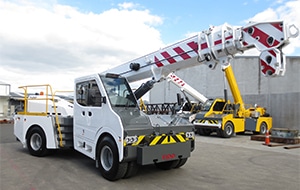Different Types of Cranes and Their Uses in Australia

Cranes have become an essential part of the construction industry and with new technology, the types of cranes that are manufactured and sold have diversified too, with specific uses and specialisations for each type of crane. It’s important to choose the right crane type, based on some important factors – such as the life cycle, how often the crane is to be used, terrain conditions, weather, and load type.
Some common types of cranes used in the Australia include pick and carry cranes, crawler cranes, all-terrain cranes, and rough terrain cranes. Each crane type has its unique uses and functionalities.
Pick-and-Carry Cranes
Pick-and-carry cranes have gained popularity as a good choice for jobs both small and large in Australia because of their versatility and flexibility. A popular type of pick and carry crane that is used quite commonly in Australia is the Franna crane.
Franna cranes are mobile hydraulic cranes that can be driven on the road – making them the ideal choice for a variety of applications.
Franna cranes have a lifting capacity of up to 25 tonnes, with other model options starting at less than 10 tonnes lifting capacity.
Due to their compact size and easy transportability, these cranes can be used in difficult situations with site access issues or height restrictions, easily making your way through tight spaces with a Franna pick and carry crane.
These cranes are used in a variety of industries, including mining, construction, shipping and logistics, ship building, nuclear power plants, and general lifting jobs too.
Their compactness and efficiency have led them to become one of the most useful cranes for tight jobs and should be considered for work requiring the need to enter tight spaces.
As well as being able to perform difficult tasks, pick and carry cranes also have a relatively low setup cost, allowing them to be productive and economical at the same time.
Crawler Crane
Crawler cranes are useful for challenging jobs and can be used exceptionally widely in many fields. From light lifting to heavy work, these famous cranes are commonly used in Australia. They can carry much more than the Franna crane, at 660 tons, proving its significance in many fields.
Like other cranes, they also require a low installation cost in time and money, and like Franna cranes, they are easily transportable. Many Crawler cranes are being made today, which allow extra parts, such as boom extensions, allowing you to tailor your crane to your specific job.
Unlike others, these cranes are mounted on moveable platforms and can perform various operations from many different heights. This moveable track ensures that the crane remains stable during operation, making it a very safe crane in the right hands. Like other cranes that we will explore later on, they can perform on a variety of terrains.
However, if you are interested in cranes that can perform smaller jobs, this may be a crane to avoid, as it doesn’t have the versatility of Franna cranes; so, depending on the project, Franna cranes may be more useful. Nevertheless, it is still a significant crane in its respective fields, providing beneficial characteristics to specific jobs.
All-Terrain Cranes
While the other two cranes are great pieces of machinery for universal jobs in Australia, it is worth looking at cranes with more specialised functions, such as the all-terrain crane. They are specialised in rougher areas instead of the Franna crane, which may be more useful in less rugged terrain. They are built to be easily used in rough terrains and a variety of surfaces. While the other crane types may struggle in areas such as mountains, all-terrain cranes are triumphant.
Thus, while the other cranes are significantly and easily transportable on roads, these cranes are more focused on function than portability. However, this is not to say that its portability is terrible, as it can easily be driven on public roads, allowing efficient transport. But it is essential to consider that this may be less useful than cranes such as the Franna crane, as they need to be easily transportable, while these can be placed on sites which may require no need for constant transport, but this certainly depends on the project.
It is certainly worth looking at the statistics that make all-terrain cranes successful. While the Franna crane might be able to get into those tighter spots, the all-terrain cranes can lift a titanic weight of 1000 tons, allowing their purpose to be universal in the most difficult of climates.
With an average lifting capacity of over 1000 tons, all-terrain cranes can be used for anything from container lifts to lifting materials on city construction sites, making them very versatile.
Rough Terrain Cranes
Rough terrain cranes combine a mobile crane’s significance with an all-terrain crane into one heavily specialised crane type in Australia. They are used in the most challenging conditions and are specially built to ensure that they can do so. They are made with reinforced wheels and machinery to deal with harsh terrain.
However, unlike the mobile crane, the rough terrain cranes can fit into tight areas as the Franna crane can because it is as compact as a Franna crane, allowing said access to occur. Thus, they are highly moveable and are functional to do so. They may be large, but their function compliments this for the terrain on which they perform.
As you can see, there are a wide variety of crane types, each with their unique uses and specifications. You may prefer an all-terrain crane for your project that requires useability on a variety of terrains. Or you may want to use a rough terrain crane if you know that what you will be working on will be on a specific type of rugged terrain. Nonetheless, you may prefer a traditional Franna crane for smaller projects. The choice is up to the firm conducting the project on what cranes are appropriate.







